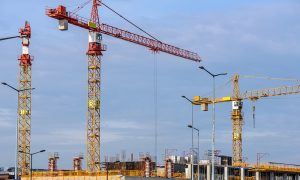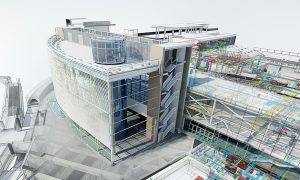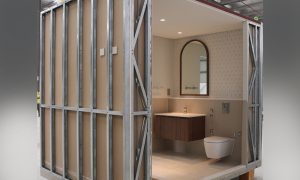A deep dive into immersive technology for construction
If you’re a consultant, you are regularly faced with major challenges, one of which is decision-making. Delays and rework caused by late decisions made by your team, the client or stakeholders pose a significant risk for construction projects.
We’re in the business of building. Private and government clients procure infrastructure and building projects expecting a return on their investments. Market conditions are entering a tough period for the GCC. During 2016, GDP growth is half what it was in 2012 and will continue to hover at around 3.0%. Government revenue is dropping but populations are growing. While across the GCC there is a project pipeline for construction and transport infrastructure valued at $705 billion, the already crowded supply chain has to find more ways to reduce risk while still delivering competitively and safely.
Immersive Technology (ImT) is an emerging solution for engaging audiences in construction projects, helping collaborators experience their project at the human scale and intuitively interact with spatial information. IT vendors are supplying data management and visualisation tools to help collaborators understand their projects as well as the impact of their decisions.
Digital design is a norm in the construction industry and offers opportunities for stakeholders to reduce risk and costs. ImT is the missing piece for clients and stakeholders to review this digital data, providing spontaneous ways to interact with it.
ImT is an umbrella term for virtual reality (VR), augmented reality (AR), virtualisation, mixed reality and other interactive experiences. Virtual reality is a visual and aural experience using a headset covering the user’s complete field of vision, giving the experience of being entirely wrapped in a digital environment. Augmented reality imposes digital content onto the real world by using a smartphone, a headset or other projection hardware. Digital content can comprise 3D models, animations or multi-media. Other ways to engage with digital content include immersion projection caves which are three (or more) sides of a room with 3D projection and head tracking to provide a life-like experience similar to VR but without a headset.
Immersive technology provides value for all stakeholders during every stage of the construction lifecycle. Masterplanners use visualisation for public consultations and stakeholder interfacing. During this stage, clients communicate their plan, garner approvals and engage consultancy services. Virtual and augmented realities are fantastic engagement tools, leveraging the web to spread content. In the early design stages, clients and consultants work back and forth, realising the design intent and solidifying the physical form of the project. Virtual reality also provides an interface to understand the breadth of a project for final users, while providing a digital meeting space for collaborators to work together.
Contractors face different challenges, working within a defined scope and budget to deliver projects on time. On large projects, the major challenge for all parties is understanding and quantifying the volume of work. Easily quantifiable and understandable projects give confidence to the client. Delivery of the project has its own challenges, and contractors typically need to further develop the design as well as deliver the project. This is where immersive technology helps contractors visualise and integrate models when bidding. They can also leverage the spatial data during the delivery phase. Users and facility managers use AR as a way of finding inspection data where it’s needed.
Infrastructure stakeholders differ from private development stakeholders. During the early stages, the client and statutory authorities are recipients of the design data, whereas in later stages the contractor and technical contributors such as structural engineers are recipients. Immersive technology is the perfect tool for both stages, enhancing traditional drawings, renderings and documentation. In developments for private clients, use of design data also changes from concept to schematic design. The client remains custodian and uses the data to communicate, conceptualise and quantify design development. Typically, the client engages a third party to manage transfer and use of data. Immersive technology allows non-construction professionals to review, evaluate and quantify parts for the developing data set.
Digital delivery is here to stay and adoption is extending across all markets, including construction. We are entering the period of virtual reality, normalising the use of headsets to explore digital models. Apple, Microsoft, Qualcomm, Samsung, Facebook, Google and other digital giants are heavily investing in the development and promotion of immersive technology in an attempt to revive a stagnant mobile industry, as well as create new ways of selling ImT services.
In 2017, we are likely to see a maturing of virtualisation technology with ‘mixed reality’ devices capable of fully immersive experiences as well as augmented experiences. The entertainment industry sets the standard for computer visualisation and interactivity – achieving this level of realism is challenging in the construction industry. Movies and games sell millions of copies, but immersive experiences are procured and consumed by a much smaller group. Immersive technology leverages 3D models developed for traditional visuals and animations, providing innovative and additional ways to interact with the same content.
Within the construction industry, Building Information Modelling (BIM) projects provide a perfect platform for use of immersive technology across the project lifecycle. BIM implies the use of data-rich 3D models with increasing levels of development during design progression. Immersive technology integrates into every stage, from concept through to bidding and tendering, to documentation, supervision and operation.
A BIM project involves digitally savvy collaborators, so VR and AR are a natural extension for all parties. ‘Instant VR’ allows designers to explore their schemes with low visual fidelity and instantly accessible PC hardware typically found in engineering offices. High-quality visuals and interactivity requires additional data embedded in the BIM and high-end hardware to deliver. To leverage BIM data fully and integrate immersive technologies, the use of virtualisation must be identified by the client at an early stage.
Immersive technology reduces risks and costs involved with design, programme, construction management, procurement and operation – encompassing the full construction lifecycle. Immersive technology is scalable, from simple cardboard VR viewers to million-dollar holographic rollercoaster simulation. This year will see VR become mainstream for gamers and early adopters. In the near future, we will see the growth of immersive technology into a viable media experience for a range of audiences, benefiting all collaborators in the construction industry.
Charles Dunk is Associate Director, Immersive Technologies, UAE & Oman at Aecom

























